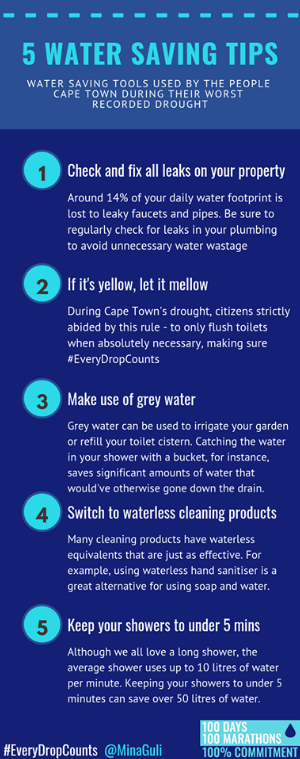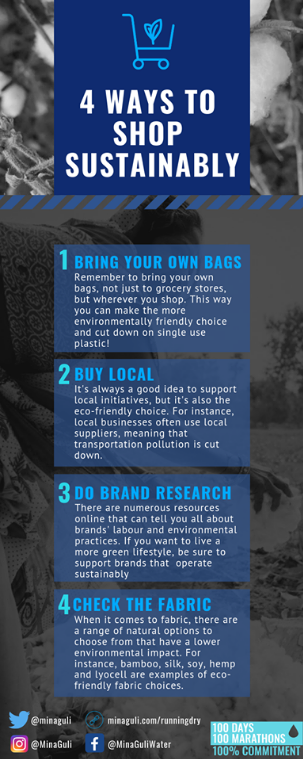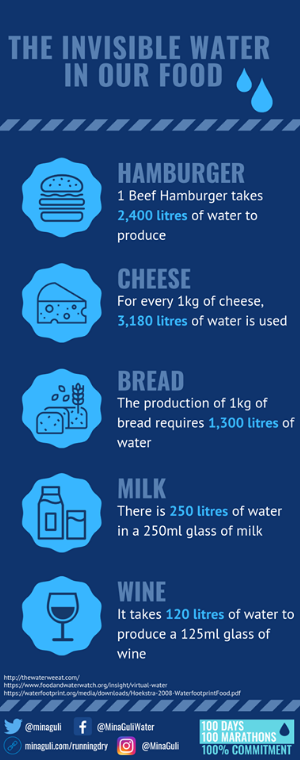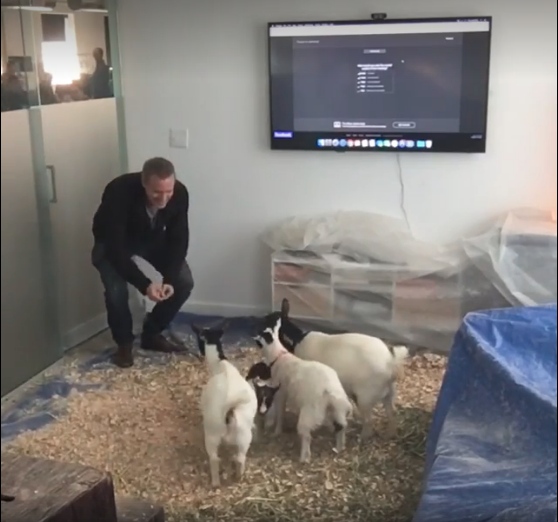How #RunningDry grew from a campaign to a movement
The #RunningDry campaign got over 1.6 billion organic media impressions, including coverage from ABC, Bloomberg, CNN, The Times of India, Washington Post, Fox News and hundreds of others. Here’s how Treeshake helped Mina Guli ensure #everydropcounts
Thousands of runners from over 50 countries. Coverage from the likes of ABC, Bloomberg, CNN, The Times of India, Washington Post, Fox News and hundreds of other publications. A total of over 1.5 billion media impressions in just over 3 months. Here’s how we did it.
Mina Guli, CEO of Thirst, uses the sport of ultra-endurance running to get people engaged in water saving. She approached Treeshake to run the media, digital, and PR for #RunningDry, a campaign to raise awareness of the global water crisis.
This is What 100% Commitment Looks Like
On a chilly November morning in November 2018, Mina Guli set off to run the New York Marathon. The next morning she would wake up and run her next marathon. And the plan was to keep running until the media took notice.
Specifically, Mina was committed to run 100 consecutive marathons in 100 days, while travelling to places that show people the affects of the global water crisis. An insanely large challenge. Her idea was to communicate clearly that nothing less than 100% commitment would help us avert a global water crisis.
The basic plan was to tap into the global community of ultra endurance enthusiasts around the world who would automatically be drawn to this kind of challenge. That interest would be used as a trojan horse to bring the issue of water into people’s news-feeds. Combined with adventure travel, world class photography, and real-time storytelling it is a brilliant way to get people engaged in an issue they may not otherwise be interested in.
Two major brand sponsors, Colgate and Reebok, came on-board to cover travel and production costs.
But even with all this lined up, it was only when things when horribly wrong that the campaign took off. And that’s where the power of community really kicked in…
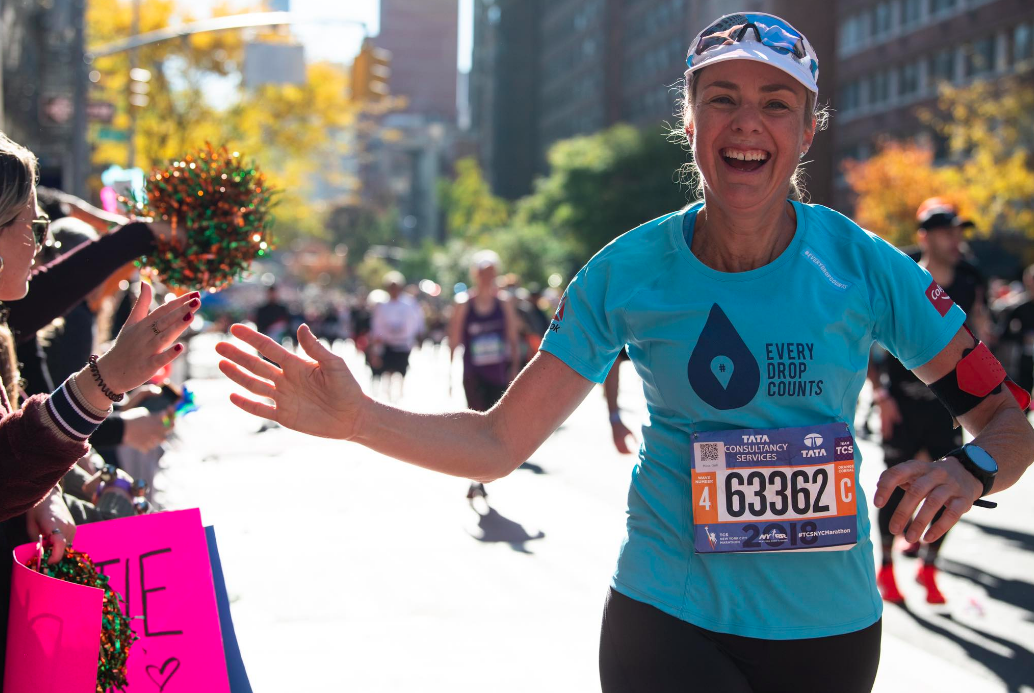
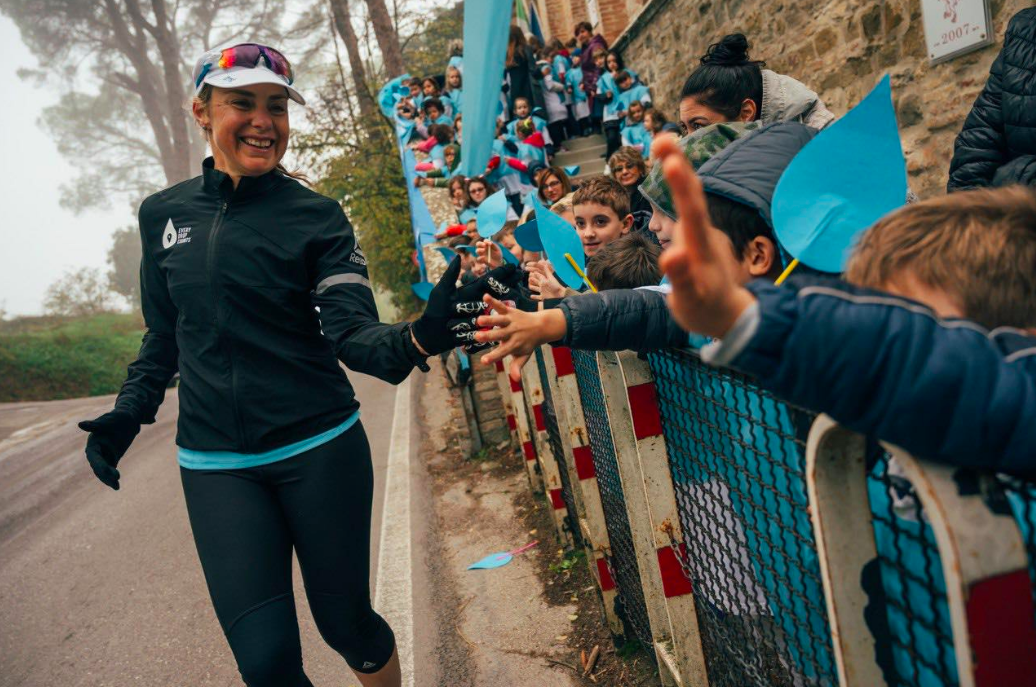
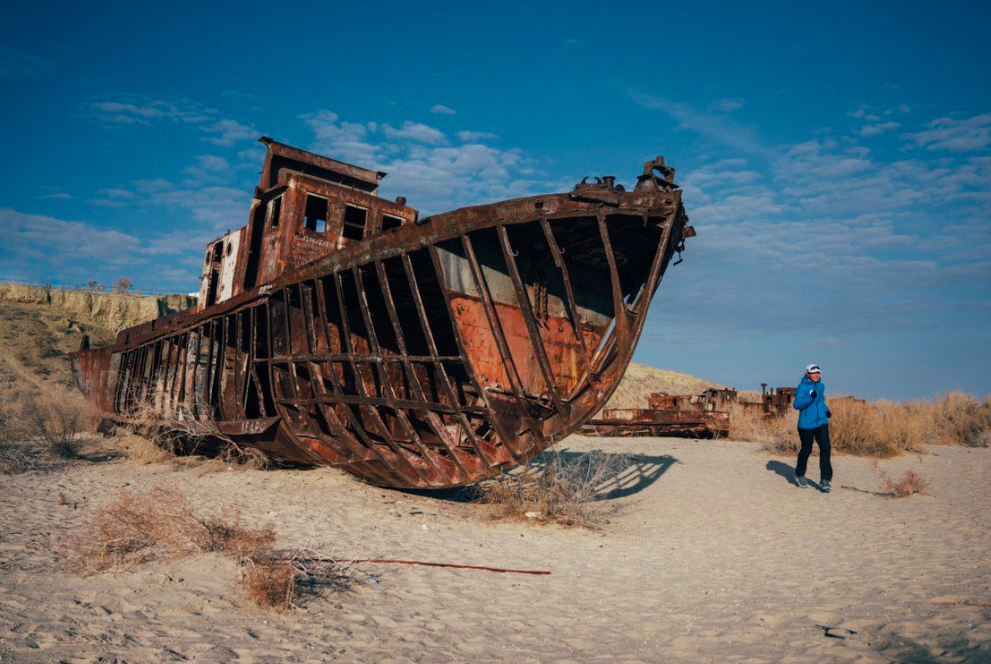
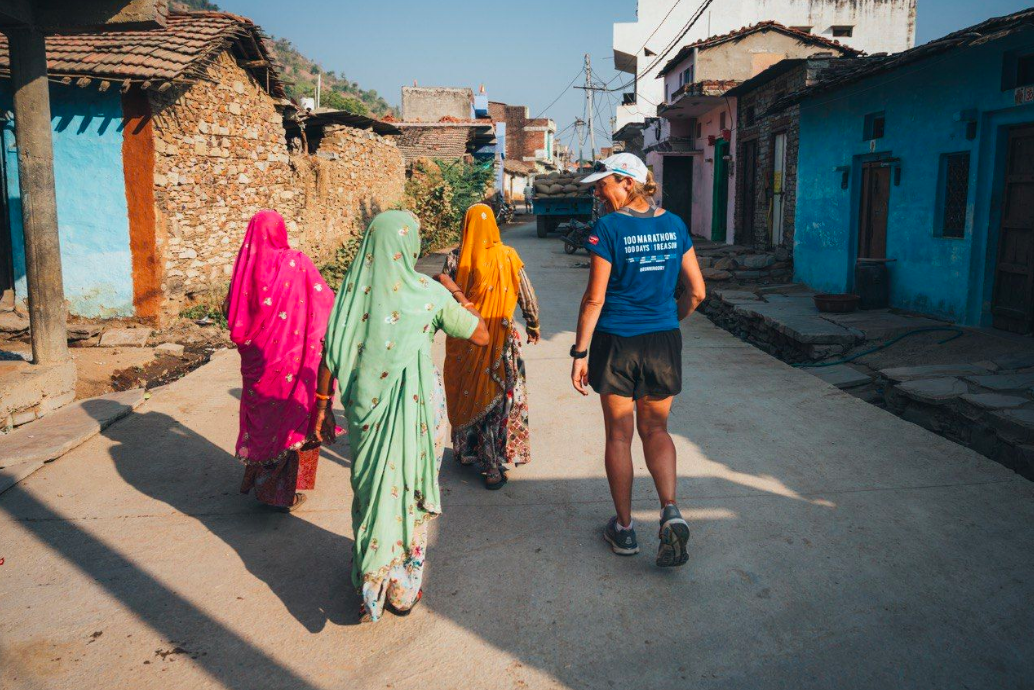
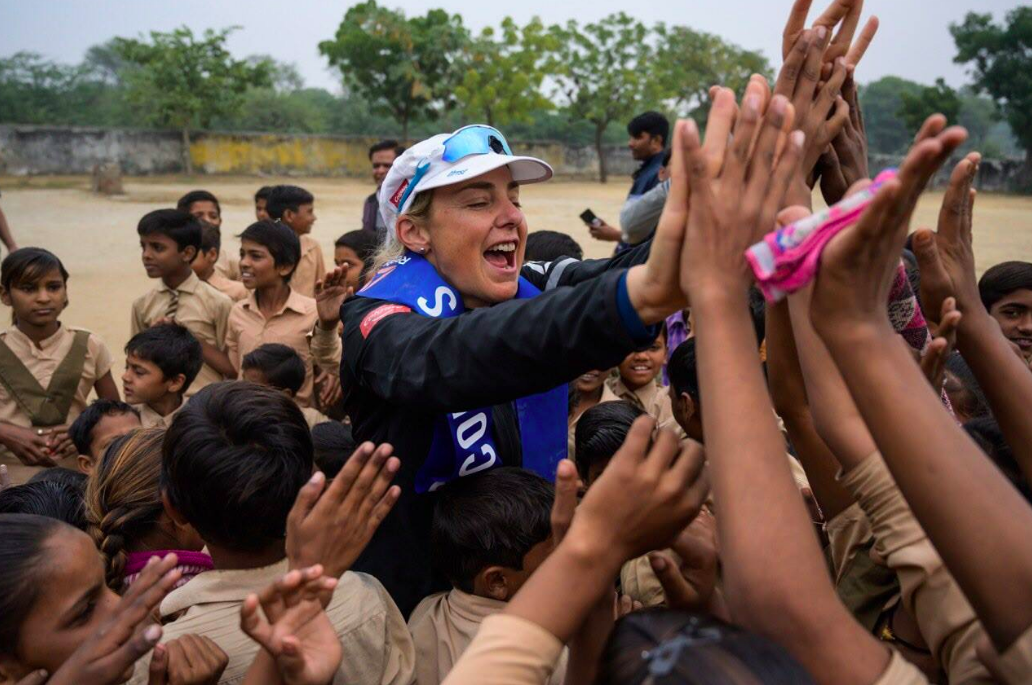

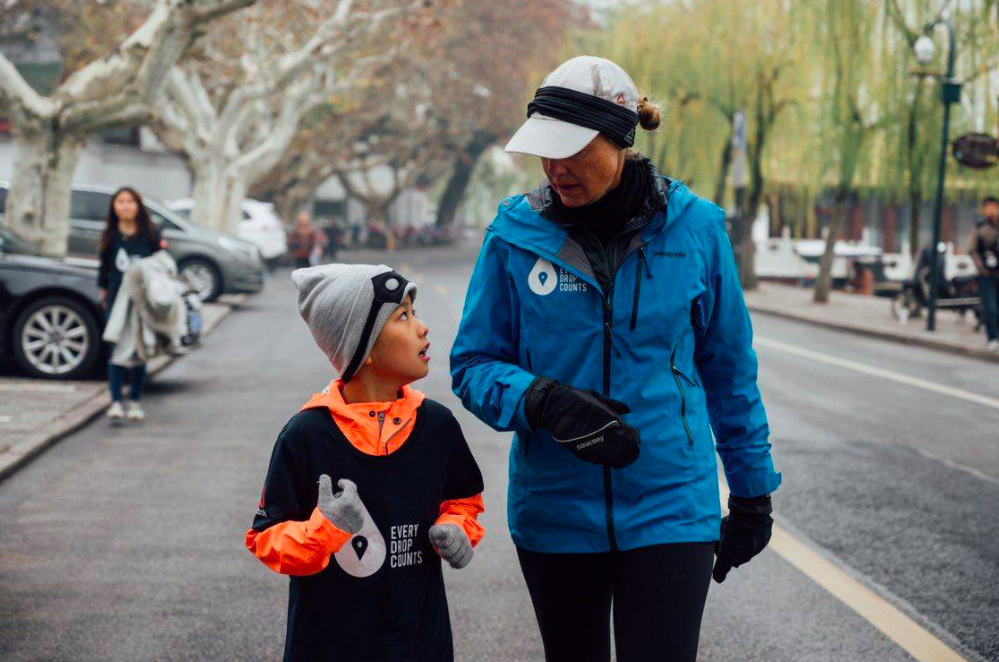
Photos: Kelvin Trautman
A team of storymakers
To sustain interest and build momentum over 100 days, it was really important to develop a content plan with built-in surprises, highlights and spectacular images. From Treeshake, we had Dave Duarte as Campaign Director; Bridget McNulty as Creative Director; Jaidan Rumboll as Community Manager; and Kelly Burke as Global PR lead.
Mina would be travelling with photographer Kelvin Trautman and videographer Jared Paisley. So, the first task was to find places for Mina to run that told the story, and would look good on camera. We also identified “water heroes” for her to meet along the way, and created infographics with key facts and tips about invisible water - the huge amount of water that goes into producing our food and clothing without us even being aware of it.
The Water Heroes turned out to be a key driver of the success of the campaign. We identified the most influential people in water in each of the locations Mina was due to run, and decided to celebrate one water hero every day with a blog post and tweet. This was a lot of work, but was one of the hidden drivers of the success of the campaign. The water heroes gave us insider info, and many also became active supporters on social media.
Production is one thing, gaining attention is another. A campaign on this scale needs teams with local media contacts. Four international PR consultancies were hired to support the campaign - Fenton in the US; Fleishman Hillard in China; Frank PR in Australia; and Bubble Communications in India. These agencies gave us access to local media and helped us navigate the cultural nuances of international PR and media, which tends to differ regionally.
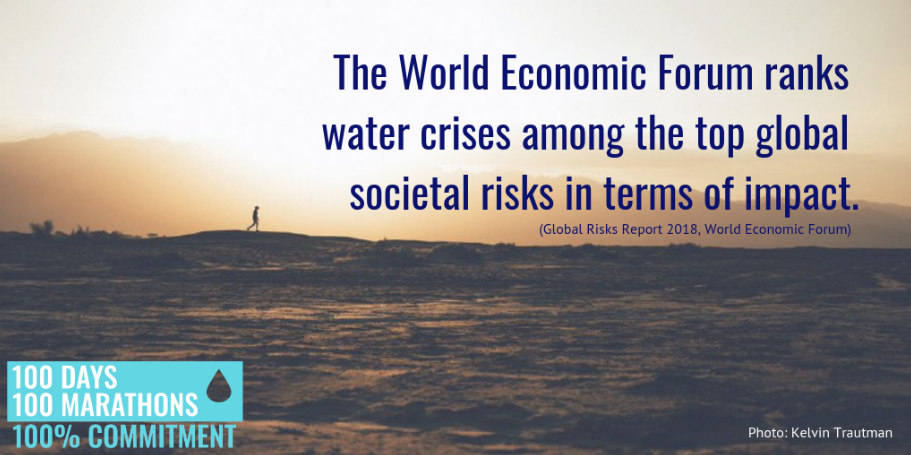
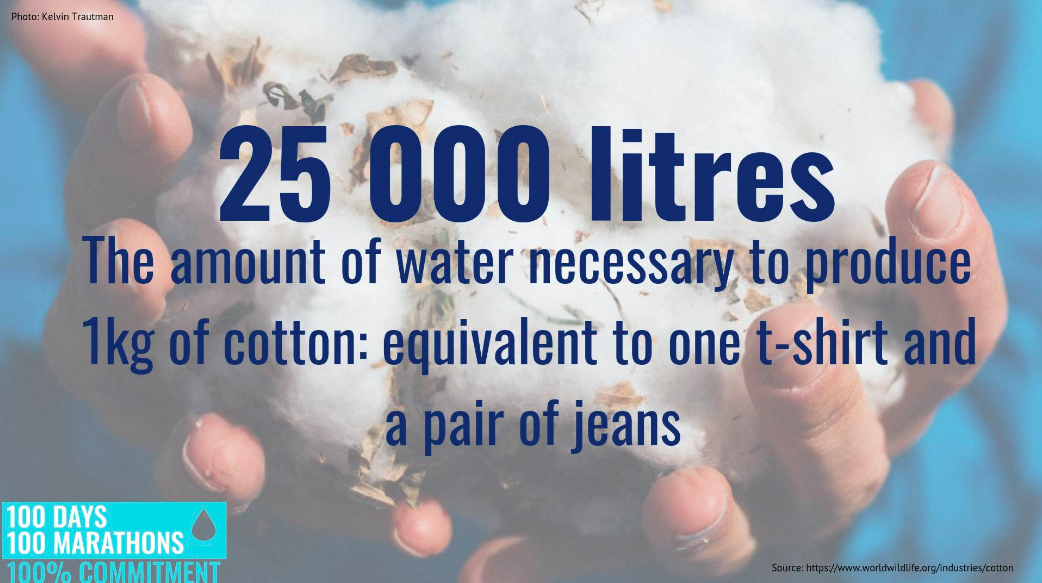
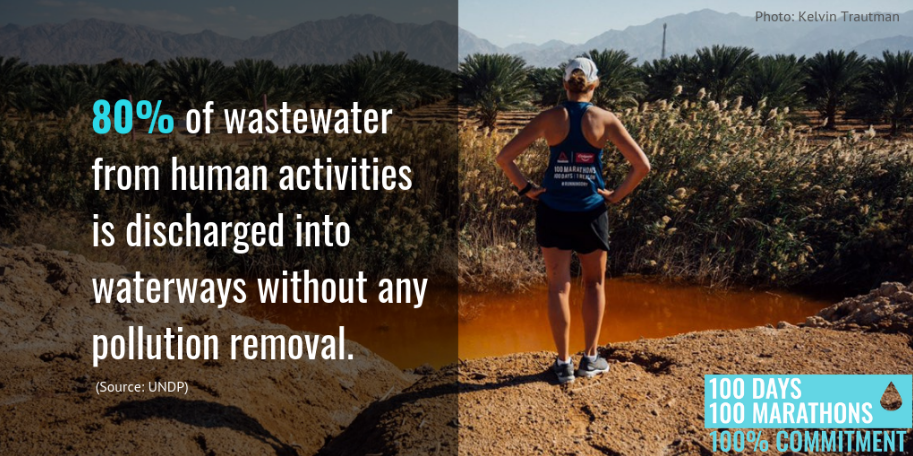
100 day logistics
The ground team travelled far, and fast, with Mina running a marathon every single day. Starting at the New York City Marathon on 4th November 2018, the team went across Europe (UK, France, Italy), Uzbekistan, India, China, Hong Kong, Dubai, the Middle East (Jordan, Palestine, Israel), South Africa, and Australia before crossing over to the USA and finishing the 100-day journey back where they started in New York on the 11th of February 2019. What this meant, logistically, is that often Mina would fly to a new country overnight, do media on arrival, drive a few hours to meet a water hero, and then run. A whole marathon. The schedule alone was a feat of endurance.
This would not have been possible without our brilliant and accomplished Chief of Staff, Melanie Ho who handled ALL the logistics - a daunting task considering the amount of travel, equipment, permits and more that needed to be arranged.
This kind of travel is not cheap, but was made possible by headline sponsors Reebok and Colgate. It was important to position the campaign and the sponsorship arrangement in a way that both benefited the sponsors and added to the campaign narrative. This was, and is, key to Mina’s campaigning model. To quote a New York Times piece about the campaign.
“Guli, 48, is part of a class of runners now picking up sponsorships the same way top-level runners coming out of college do. They won’t be winning the Boston Marathon or Olympic medals, but they offer something that shoe brands want to be a part of at a time when the top of the podium isn’t the only spotlight… Reebok and other companies are going after unique narratives they hope will inspire people.
Video: Jared Paisley
Consistently high social engagement
It was a gruelling pace, but right from the start the stories we were able to tell - on Facebook, Instagram, Twitter and Mina’s blog were beautiful, and heartbreaking. The global water crisis was being shown in true human form, and we were getting respectable numbers of video views organically. With attention to detail in ensuring that each community member felt appreciated and heard, social media engagement rates rose and were consistently higher than the norm. For example:
Facebook: 2.3% (Average Facebook engagement rate: 0.5%-1%)
Instagram: 7.9% (Average Instagram engagement rate: 2%)
Twitter: 1.7%. (Average Twitter engagement rate: 0.9%-1%)
With engagement growing, our focus on narrative, influencer partnerships, and community engagement was really paying off. By this stage Mina’s accounts had grown from around 10 000 followers to around 50 000 followers in the space of two months, we’d had respectable media coverage online, on radio, TV, and print. By all accounts it was going excellently.
An unexpected twist
Around marathon 50 Mina began walking her marathons, and they were taking more than 12 hours a day to complete. We decided to cancel her Ethiopian runs, as the relentless travel was also taking a toll. She came to South Africa and took an MRI, which verified what the whole team had feared: Mina had multiple stress fractures in her femur. Mina revealed this to the #RunningDry community in an honest video and series of photographs that many supporters said was a refreshing break from the airbrushed perfection of social media. She spoke to them person to person, sharing her vulnerability and despair at being injured.
While this was unfolding, Beaufort West, a town in the Western Cape of South Africa, literally ran dry. As terrible as this was, it was an opportunity to show the world what we were saying. Limping along, Mina joined local disaster relief organisation Gift of the Givers on the ground to donate water to the residents. It was a heartbreaking and powerful few days, and we told the story far and wide on local and international media. And then, Mina couldn’t go on.
Mina ran 62 marathons in 62 days, but on day 63 she was told by doctors that if she ran any more she would never run again. In fact, the fractures had grown since the time of her first MRI - she ran so hard she broke her leg.
As devastated as she was, we knew this was story gold. And so we kept asking the question “How does this make things better?” - an important question to consider in almost any crisis.
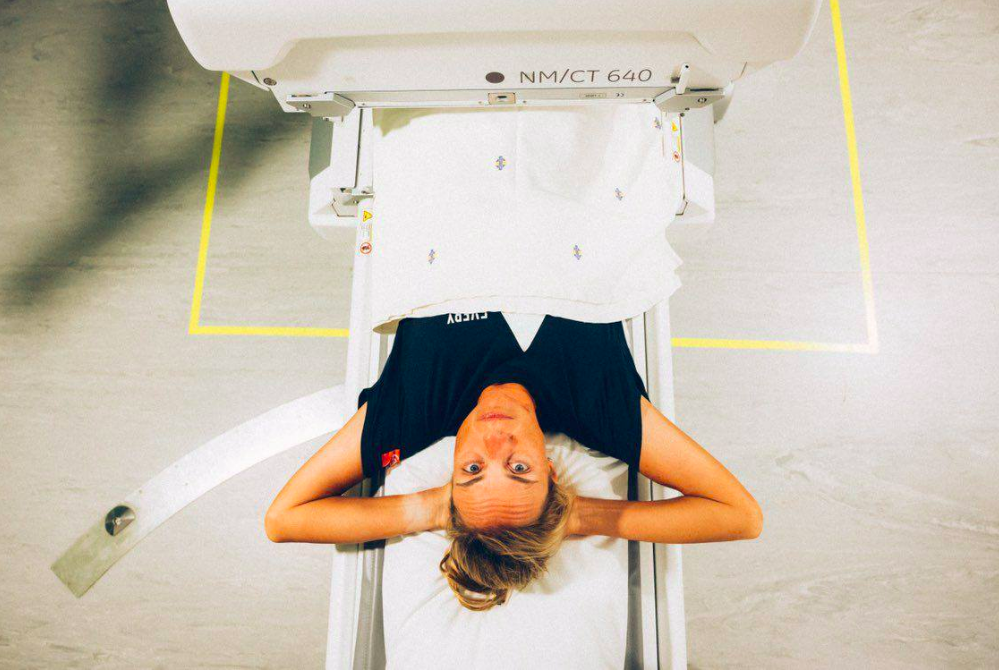

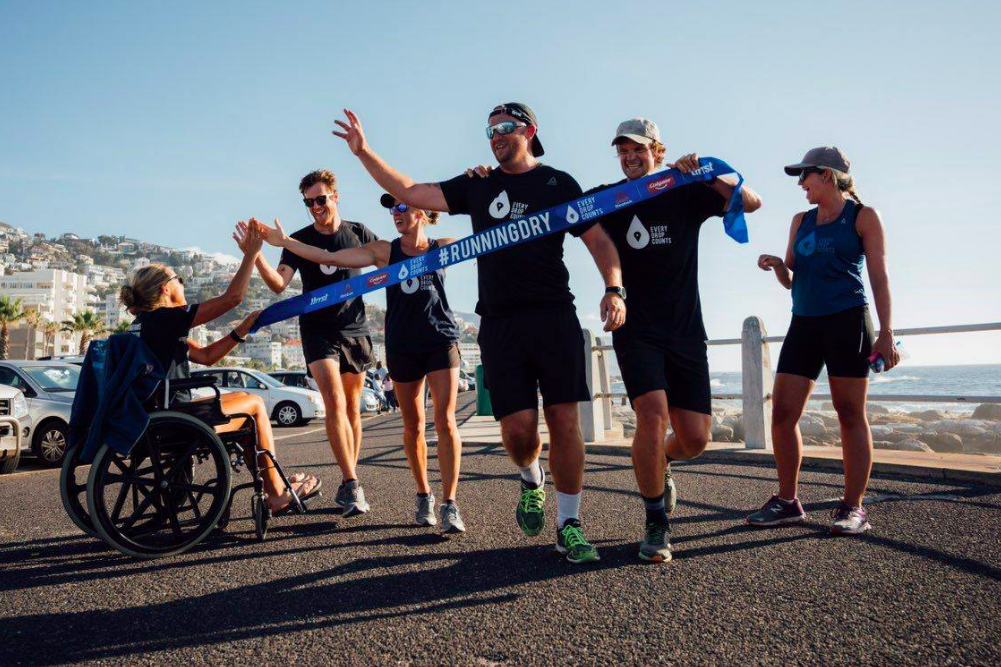

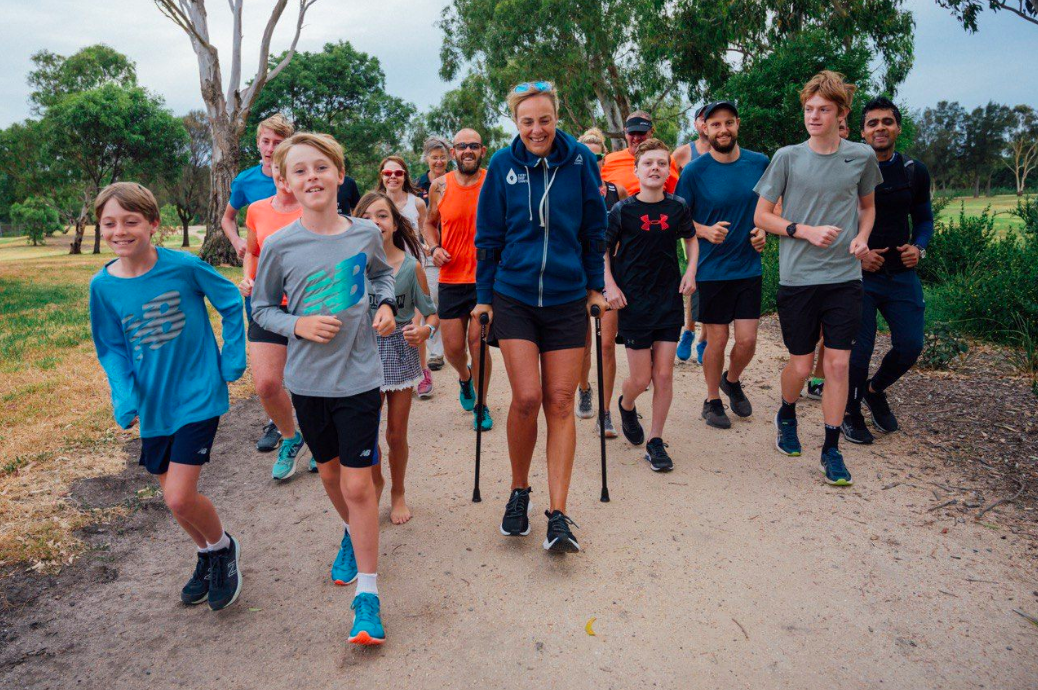
Photos: Kelvin Trautman
Campaign to movement
A few of Mina’s supporters had commented on her injury video, saying they wished they could run a marathon for her. We took this community led idea as our strategic cue, and realised this was how we would turn crisis into opportunity.
This was the point in the hero’s journey where the mentor would be needed to guide the hero through the transition. Lewis Pugh has played this role for both Treeshake and Mina and we asked him for his advice and support to help us all through this transition in the campaign and the story. He met Mina at the hospital and advised her that it was time to let others pick up the baton.
Starting off with a team run, we introduced the idea of Mina’s supporters completing her daily marathon for her. There was a lot of discussion about the dynamics of how we’d track success, and it was decided ultimately that we wouldn’t ask people to run full marathons but rather tally up ALL contributions - whether 1km or 100kms in a day.
The first follower was Bruno Sanchez from Madrid, who ran a full marathon for Mina as soon as the request was put out. That same day, we mobilized supporters in Cape Town, where Mina was that day, to contribute kilometres to the cause. The images and story were picked up by the Associated Press worldwide, and from there the #RunningDry movement began
A real community
Our team worked hard to make sure every single person who contributed distance to #RunningDry felt validated, and noticed. We replied to every comment, reached out on DM to thank people, and shone a spotlight on the community who was not only doing Mina’s distance for her, but also sharing water facts and helpful tips along the way.
To incentivise and acknowledge the community we also provided a daily tally of miles, posted on Twitter, which listed every person who contributed and ranked their distance. This proved to be a key motivator for people who contributed, as they knew that every extra mile they put in was being counted and made a difference in showing the scale of our movement.
Even though we’d only set out to log one marathon a day, hundreds of people were contributing runs that far exceeded this target. It was then that the next dream was born: Mina had set out to run 100 marathons in 100 days for water, what if the #RunningDry community ran 100 marathons in 1 day to show the power of collective action?
100 marathons in 1 day
We started working on the idea - reaching out by Direct Message to anyone who had contributed miles and asking for their support in the challenge, creating a special page on Mina’s website explaining exactly what to do, adding a pop-up so that anyone who visited the site would know about the marathon attempt. We set up a folder of easily shareable infographics on Facebook and punting the water saving messages we wanted to promote, and to let people know that we could only achieve this if we all worked together. On Sunday 27th January 2019, we attempted 100 marathons in 1 day, and we were blown away.
Mina’s vision for the 100 marathons in 100 days #RunningDry campaign was simple: to make saving water famous. Just over 2 weeks after announcing her injury on social media, the vision became a reality with #RunningDry becoming a worldwide movement.
As of midnight on the 27th of January, 251 marathons had been logged: an incredible distance of 10,629.3km. People donated kilometres from 44 different countries and territories - from Antarctica to Sweden, Mexico to Japan, Australia to Serbia and everywhere in between. Supporters logged distances from 1km to over 50km, in temperatures from -15°C to over 40°C, in deserts, snow and in forests. People ran by rivers and others by oceans and waterways. Some ran in cities and on tracks. Some ran in groups and others on their own. But every single one of them donated their miles on Sunday to support #RunningDry and help drive global water awareness.
Results
The reach of this campaign has been phenomenal. Press releases were picked up by the Associated Press multiple times and pushed to print, TV and radio around the world. The total online audience, according to Critical Mention, is 1,590,084,059 and growing daily. The estimated media value is currently sitting at over $100 million.
The rapid growth of the community online has been equally gratifying. Mina’s social media pages gained 232,506 new followers and fans throughout the campaign - with 24,830 new followers in just one week building up to the #RunningDry “100 marathons in one day” activation we did in late January.
There was an outpouring of positive comments and water facts shared, with users around the world taking to social media to share why they were running for water.
Finally, in April 2019 the United Nations selected the campaign as a top 3 finalist in their annual SDG Action Awards.
This documentary produced by ABC about Mina and the campaign tells the whole story and is well worth watching:
The Taste Gap
So many of us get into social media because we admire the work of creatives in the field, the brilliant memes, the awe inspiring videos, the perspective altering tweets. But there’s a gap when we start. What we produce doesn’t live up to our own expectations. Ira Glass’ insights on the creative process remind us to push through the frustrating beginnings of creative work, and keep working until what we produce reflects our good taste
Recombiner
So many of us get into social media because we admire the work of creatives in the field, the brilliant memes, the awe inspiring videos, the perspective altering tweets. But there’s a gap when we start. What we produce doesn’t live up to our own expectations. Our taste exceeds our ability.
“A lot of people never get past this phase," notes Ira Glass because they succumb to the disappointment of producing work that doesn’t match up to the sky-high expectations set by their taste. Every creative has at least once considered packing it in and pursuing the most un-creative career trajectory possible, simply to avoid the heartbreak of knowing their work doesn’t quite cut it.
by Recombiner
“In the beginning, and for a while afterwards we know our work doesn’t have this special thing that we want it to have,” says Glass. “We all go through this. And if you are just starting out or you are still in this phase, you gotta know it’s normal and the most important thing you can do is do a lot of work. It is only by going through a volume of work that you will close that gap, and your work will be as good as your ambitions. It’s gonna take a while. It’s normal to take a while. You’ve just gotta fight your way through.”
It’s tempting sometimes just to stop trying to be excellent, to start filling the content calendar with “content” rather than striving for the breakthrough executions that get noticed and engaged with. So even as you cringe at your first attempts, recognise the taste gap. Then get back to writing your headline 25 times until it’s as catchy as it can be.
And maybe - if you work damn hard at it - your ability will catch up with your taste.
Ira Glass on the Creative Process:
Related Skill
Book a course related to this article:
Cultural Cartography: How Buzzfeed organises their content
Last year, Buzzfeed started a project to formally categorize their content. They called it "cultural cartography." It formalized an informal practice that they've had for a really long time: don't just think about the subject matter; think also about, and in fact, primarily about, the job that your content is doing for the reader or the viewer.
By Dao Nguyen
Last year, some BuzzFeed employees were scheming to prank their boss, Ze Frank, on his birthday. They decided to put a family of baby goats in his office.
BuzzFeed had recently signed on to the Facebook Live experiment, and so naturally, we decided to livestream the whole event on the internet to capture the moment when Ze would walk in and discover livestock in his office. We thought the whole thing would last maybe 10 minutes, and a few hundred company employees would log in for the inside joke. But what happened? They kept on getting delayed: he went to get a drink, he was called to a meeting, the meeting ran long, he went to the bathroom. More and more people started logging in to watch the goats. By the time Ze walked in more than 30 minutes later, 90,000 viewers were watching the livestream.
Now, our team had a lot of discussion about this video and why it was so successful. It wasn't the biggest live video that we had done to date (the biggest one that we had done involved a fountain of cheese). But it performed so much better than we had expected. What was it about the goats in the office that we didn't anticipate?
Now, a reasonable person could have any number of hypotheses. Maybe people love baby animals. Maybe people love office pranks. Maybe people love stories about their bosses or birthday surprises. But our team wasn't really thinking about what the video was about. We were thinking about what the people watching the video were thinking and feeling. We read some of the 82,000 comments that were made during the video, and we hypothesized that they were excited because they were participating in the shared anticipation of something that was about to happen. They were part of a community, just for an instant, and it made them happy.
So we decided that we needed to test this hypothesis. What could we do to test this very same thing? The following week, armed with the additional knowledge that food videos are very popular, we dressed two people in hazmat suits and wrapped rubber bands around a watermelon until it exploded.
Eight hundred thousand people watched the 690th rubber band explode the watermelon, marking it as the biggest Facebook Live event to date.
The question I get most frequently is: How do you make something go viral? The question itself is misplaced; it's not about the something. It's about what the people doing the something - reading or watching - what are they thinking?
Now, most media companies, when they think about metadata, they think about subjects or formats. It's about goats, it's about office pranks, it's about food, it's a list or a video or a quiz, it's 2,000 words long, it's 15 minutes long, it has 23 embedded tweets or 15 images. Now, that kind of metadata is mildly interesting, but it doesn't actually get at what really matters. What if, instead of tagging what articles or videos are about, what if we asked: How is it helping our users do a real job in their lives?
The Cultural Cartography of Social Content
Last year, we started a project to formally categorize our content in this way. We called it, "cultural cartography." It formalized an informal practice that we've had for a really long time: don't just think about the subject matter; think also about, and in fact, primarily about, the job that your content is doing for the reader or the viewer.
Let me show you the map that we have today. Each bubble is a specific job, and each group of bubbles in a specific color are related jobs.
First up: humour. "Makes me laugh." There are so many ways to make somebody laugh. You can be laughing at someone, you could laugh at specific internet humour, you could be laughing at some good, clean, inoffensive dad jokes.
"This is me." Identity. People are increasingly using media to explain, "This is who I am. This is my upbringing, this is my culture, this is my fandom, this is my guilty pleasure, and this is how I laugh about myself."
The "Helps me Connect with Another Person" category
"Helps me connect with another person." This is one of the greatest gifts of the internet. It's amazing when you find a piece of media that precisely describes your bond with someone. The green bubbles make up the group of jobs that help me do something -- 'helps me settle an argument'; 'helps me learn something about myself or another person'; or 'helps me explain my story'.
The orange bubbles are the group of jobs that makes me feel something -- makes me curious or sad or restores my faith in humanity.
“If we can capture in data what really matters to you, and if we can understand the role that our work plays in your actual life, the better content we can create for you, and the better that we can reach you”
Many media companies and creators do put themselves in their audiences' shoes. But in the age of social media, we can go much farther. People are connected to each other on Facebook, on Twitter, and they're increasingly using media to have a conversation and to talk to each other. If we can be a part of establishing a deeper connection between two people, then we will have done a real job for these people.
Let me give you an example of how this plays out. This is one of my favorite lists: "32 Memes You Should Send Your Sister Immediately". It has things that are relatable, like: "When you're going through your sister's stuff, and you hear her coming up the stairs." Absolutely, I've done that. "Watching your sister get in trouble for something that you did and blamed on her." Yes, I've done that as well. This list got three million views. Why is that? Because it did, very well, several jobs: "This is us." "Connect with family." "Makes me laugh."
Now, we can even apply this framework to recipes and food. A recipe's normal job is to tell you what to make for dinner or for lunch. And this is how you would normally brainstorm for a recipe: you figure out what ingredients you want to use, what recipe that makes, and then maybe you slap a job on at the end to sell it. But what if we flipped it around and thought about the job first? One brainstorming session involved the job of bonding. So, could we make a recipe that brought people together? This is not a normal brainstorming process at a food publisher. So we know that people like to bake together, and we know that people like to do challenges together, so we decided to come up with a recipe that involved those two things, and we challenged ourselves: Could we get people to say, "Hey, BFF, let's see if we can do this together"? The resulting video was the "Fudgiest Brownies Ever" video. It was enormously successful in every metric possible -- 50 million views. And people said the exact things that we were going after: "Hey, Colette, we need to make these, are you up for a challenge?" "Game on." It did the job that it set out to do, which was to bring people together over baking and chocolate.
Metadata and Storymaking
I'm really excited about the potential for this project. When we talk about this framework with our content creators, they instantly get it, no matter what beat they cover, what country they’re in, or what language they speak. So cultural cartography has helped us massively scale our workforce training. When we talk about this project and this framework with advertisers and brands, they also instantly get it, because advertisers, more often than media companies, understand how important it is to understand the job that their products are doing for customers.
But the reason I'm the most excited about this project is because it changes the relationship between media and data. Most media companies think of media as "mine." How many fans do I have? How many followers have I gained? How many views have I gotten? How many unique IDs do I have in my data warehouse? But that misses the true value of data, which is that it's yours. If we can capture in data what really matters to you, and if we can understand more the role that our work plays in your actual life, the better content we can create for you, and the better that we can reach you.
Who are you? How did you get there? Where are you going? What do you care about? What can you teach us? That's cultural cartography.
As a Media Analytics Expert and Publisher of BuzzFeed, Dao Nguyen thinks about how media spreads online and the technology and data that publishers can use to understand why. Dao Nguyen is the Publisher of BuzzFeed, a reinvention of the traditional title in which she oversees the company’s tech, product, data and publishing platform, as well as ad product, pricing, and distribution. Nguyen joined BuzzFeed in 2012 and has been instrumental in its rapid growth as the largest independent digital media company in the world
This is an extract from a 2017 talk delivered by Dao Nguyen entitled "What Makes Something Go Viral?" delivered at TedNYC, published under a Creative Commons Attribution License
The 5 types of influencers you should work with
For the past two years Treeshake has helped Water Advocate Mina Guli get her message out online. For the launch of her latest campaign, Running Dry, we gained the support of influential leaders on social media to reach over 18m people online in a day . Here's how we did it.
Influencer marketing can be one of the most powerful ways to get people interested in an issue. Simply put, it's about getting people of influence to speak about your brand. But it's more than a tactic - considerations include making sure your campaign is actually worth talking about, and then making sure you involve the right influencers.
That's where our 5 types of influencers comes in. Most of the discussion about influencers is about a) number of followers, b) levels of engagement, and c) topic relevance. However, in practice we found that there's not ONE kind of influencer that's right for a campaign - there are FIVE. Namely, Pioneers, Amplifiers, Authorities, Participators, and Scalers.
We've shied away from the typical industry language of "brand influencers", "micro-influencers", "influencers", and "celebs" because those specifically refer to number of followers rather than the role the influencer plays in a campaign.
To illustrate how we work with these influencers, and explain the categories we'll use a live campaign example...
On World Water Day , 24th March 2018, Water Advocate Mina Guli announced that she will be running 100 marathons in 100 days for 1 reason: Water. We were tasked with getting this announcement out on social media, and ensuring that her message of water conservation came through as clearly as the message of ultra endurance inspiration.
Using our Social Media Fireworks approach, we reached over 18 million people. But as you'll see in this post, it is not only that we reached LOTS of people, it is that we were joined by the RIGHT people. Some of the most influential and credible players in the space of water conservation, sport, and business supported the launch on World Water Day by mentioning Mina's campaign directly as well as the #everydropcounts hashtag.
Here are the 5 types of influencers we message and try to involve when we do a Social Media Firework:
Pioneers
The first type of influencer we’re looking at are the Pioneers -- the cool people, the front-runners. Pioneers are plugged into the scene, they're passionate about the issues.
The idea is to let these people in on the campaign as early as possible. You may even get some good ideas from your Pioneers that will improve your message.
Ok folks - this is, as ever, another impressive effort by the amazing @minaguli . I have rarely met someone more committed to water. Go Mina!! #everydropcounts https://t.co/kTMFY8ia3I
— Giulio Boccaletti (@G_Boccaletti) March 22, 2018
By 2030 humanity will be short of water by 40%. @minaguli is running 100 marathons in 100 days to raise awareness.
— Aejaz Khan (@dotkhan) March 25, 2018
In relation to the RunningDry campaign, the Pioneer Influencers we reached out to were fellow water activists and users whose feeds consisted largely of water-related content. For RunningDry, we were lucky enough to be building on the #Run4Water campaign, where we spent months ensuring Mina was following the key Pioneers in the water crisis conversation, and often getting reciprocal follows as a result. This allowed the pioneer outreach for the RunningDry launch to be carried out a lot more easily, because we could simply look through Mina’s followers for the pioneer influencers, reach out to them via DM and often have their support based on this already existing relationship.
Amplifiers
The next type of influencer to consider is the Amplifier -- they are are interested in your topic, and have a high number of engaged followers. Generally called "Influencers" they often drive the highest volume of engagement and reach in a campaign. Generally speaking their following is in the range of 100k - 1m but just as important as their large reach is their clout as conversation leaders online (you can tell by their engagement rates generally).
The amazing @minaguli is an inspiration! @YGLvoices @CityofCT #EveryDropCounts 💦 https://t.co/Ej0DjKVGgW
— Lindiwe Mazibuko (@LindiMazibuko) March 22, 2018
"If water is life, surely water scarcity — which is going to affect all of us — should be on the front page." — @minaguli on why she started @Thirst4Water 💧 #WorldWaterDay pic.twitter.com/NMEfZjvEiz
— AM to DM by BuzzFeed News (@AM2DM) March 22, 2018
Authorities
Authorities bring an added level of trust and credibility to a campaign. We're talking about institutions like universities, leading non-profits in the space, academics, and experts on the topic.
Wow, stay hydrated. Go Mina!
— Peter Gleick (@PeterGleick) March 22, 2018
Good luck! Stay hydrated. Get in touch when you are done. https://t.co/9hInKl4IL1
— Seth M. Siegel (@SethMSiegel) March 24, 2018
For Running Dry our Authority outreach included accounts like the verified World Resources, to individual gatekeepers such as Seth Siegel, author of Let There Be Water. Their participation showed people that Mina is a trusted and credible campaigner in the space of water conservation.
Participators
Participators comprise the largest proportion of your followers. They are the people who choose to follow you simply because they like your content or what you're talking about. On aggregate, participators can be the most influential of everyone in your campaign. To gain the support of Participators you need to maintain a consistently high level of relevance and entertainment value. It also really helps to activate their involvement using other channels, such as email newsletters or calls for involvement on TV and radio interviews. And of course, acknowledge and thank people for getting involved and supporting - like posts, comment back, share.
Thanks for the moderate "impractical", Stephen. Generally, it's met with "mad" "impossible" ... but this is my 100%, all in 💧🌎
— Mina Guli (@minaguli) March 22, 2018
So right, Jenine, that's why I'm giving my all. 100% commitment: 100 marathons 100 days because #EveryDropCounts now
— Mina Guli (@minaguli) March 22, 2018
Scalers
The Scalers are Celebs with mega-reach because of their huge follower counts. Even a simple share or retweet from them can be a major boost. Having their support helps you take your campaign into the mainstream.
Relatively light engagement from celebrities including Maria Sharapova, Karen Davila, and Don Riddell brought the campaign into millions of people's timelines. These were unpaid endorsements based on the strength of Mina's story and the importance of her message.
Incredible. 👊🏻🙌🏻 https://t.co/VYQ7omHYIU
— Maria Sharapova (@MariaSharapova) March 22, 2018
It’s #WorldWaterDay! Please check out my friend @minaguli’s page! She has run the world - giving attention to the water crisis! 💦💦 https://t.co/R2kRRF4XpE
— Karen Davila (@iamkarendavila) March 22, 2018
Online and Offline Influence
Lastly, Mainstream Media and Social Media are a great compliment. It's always encouraging for news organisations to see that an issue is gaining traction online. So thanks to supporters like CNN's Don Riddel and Al Arabiya's Talal Al Haj, Mina's story was carried off social media and into millions of homes around the world by broadcast television.
Diplomatic Avenue - @MinaGuli talks to Al Arabiya's @TalalAlhaj on why she is running 100 marathons in 100 days to raise awareness regarding #watercrisis https://t.co/ccMqdoYt08 pic.twitter.com/bGKoNkD77D
— Al Arabiya English (@AlArabiya_Eng) March 31, 2018
Highlighting the perilous state of our global water supply, the amazing @minaguli is planning 100 Marathons in 100 Days: https://t.co/RN1RGc5wnP
— Don Riddell (@donriddellCNN) March 26, 2018
Dave Duarte on How to Grow a Social Movement
In his talk Dave shares some of the methods that we at Treeshake have used to run campaigns that have reached over 1b people this year.
Last month, Treeshake founder Dave Duarte spoke at Think Future, a gathering of 233 participants from 20 countries who all work in the field of early childhood development.
In the video below Dave shares some of the methods that we at Treeshake have used to run campaigns with a combined reach of over 1 billion this year.
Video by Innovation Edge, Nov 2017
You can download the slides to follow along with the presentation here (3mb .pdf)
What is Social Currency? Why do you need it, and how you get more of it?
You know what's cool? Social Currency is cool. Social Currency is what you have when you participate in a hot topic and contribute valuable discussion points. It's what you have when you discover some juicy gossip before anyone else. Social currency is knowing something that others want to know. It's relevance that you can exchange for benefits ranging from money to esteem to friendship and more.
You know what's cool? Social Currency is cool. Social Currency is what you have when you participate in a hot topic and contribute valuable discussion points. It's what you have when you discover some juicy gossip before anyone else. Social currency is knowing something that others want to know. It's relevance that you can exchange for benefits ranging from money to esteem to friendship and more.
The paradox of social currency is that the more you share it, the more you have it. The trick is: it's time sensitive. You need to share your currency when people are most likely to find it interesting, and that is increasingly as it happens.
To see social currency in action, go to Twitter and have a look at the trending news topics. On every topic people are sharing memes and insights to the discussion. What do they get from it? Social Currency. But it doesn't spread evenly, here the Matthew Effect applies: "to those who have shall be given more"
Fashion is also a form of social currency. A look is hot for a small time, and if you get onto the trend early you benefit the most from it. Fashion through the lens of a sociologist is basically a conversation - it's showing that you're plugged into the stream of coolness and style.
According to Wikipedia, the concept of social currency derives from Pierre Bourdieu's social capital theory and relates to increasing one's sense of community, granting access to information and knowledge, helping to form one's identity, and providing status and recognition.
Social Currency is one of the primary reasons why content spreads online. Jonah Berger, who has spent a decade investigating what makes things go viral, says there are 6 principles of virality (STEPPS):
Social currency – we share what makes us look good.
Triggers – we share what’s at the top of our minds.
Emotion – we share what we care about.
Public – we imitate what we see people around us are doing.
Practical value – we share things that have value to others.
Stories – We share stories, not information.
How do you get more of it?
Gathering social currency is not just about sources of information, it is about your own skills and ability to make sense of the information you get and share it with panache. As with most things social, you need to develop momentum - developing habits and systems to feed you fresh insight, developing trusted sources, and growing your following as you interpret the info you get.
Some practical tips:
- participate in live events and conferences where thought-leaders and pioneers are speaking and attending.
- curate your news feeds for relevant insight
- participate in Twitter trending topics and see how much traction you can get with your commentary.
The Matthew Effect in Social Media
Famous for being famous. New followers because you have so many already. To those who have shall be given more. A social power law we can see playing out all day every day.
Why do seemingly inane videos like "Charlie Bit My Finger" have SO MANY views? It's the Matthew Effect in action.
Famous for being famous. New followers because you have so many already. To those who have shall be given more.
We call this the Matthew Effect. From the Bible:
For whoever has will be given more, and they will have an abundance. Whoever does not have, even what they have will be taken from them. — Matthew 25:29
Algorithms tend to favour already-popular content. And we already know how persuasive popularity is.
Via Wikipedia:
In the sociology of science, "Matthew effect" was a term coined by Robert K. Merton to describe how, among other things, eminent scientists will often get more credit than a comparatively unknown researcher, even if their work is similar; it also means that credit will usually be given to researchers who are already famous. For example, a prize will almost always be awarded to the most senior researcher involved in a project, even if all the work was done by a graduate student. This was later formulated by Stephen Stigler as Stigler's law of eponymy — "No scientific discovery is named after its original discoverer" — with Stigler explicitly naming Merton as the true discoverer, making his "law" an example of itself.
Merton furthermore argued that in the scientific community the Matthew effect reaches beyond simple reputation to influence the wider communication system, playing a part in social selection processes and resulting in a concentration of resources and talent. He gave as an example the disproportionate visibility given to articles from acknowledged authors, at the expense of equally valid or superior articles written by unknown authors. He also noted that the concentration of attention on eminent individuals can lead to an increase in their self-assurance, pushing them to perform research in important but risky problem areas.
So How Do You Beat the Matthew Effect
The Matthew Effect is not something you can beat, it's something you can use. Unfortunately it's true that it is harder to gain attention when you start. But it is also your best opportunity to be Surprising.
This is why we work with the Hot Content model to develop social momentum.
Why targeting a small audience can help you reach a larger audience online
By trying to appeal to everyone, you will end up appealing to no-one. A key principle when developing a campaign is that you identify a core inner-circle of people who are likely to respond to it and care about it. This takes courage and conviction. It means that in your messaging, in your creative concept, and in your targeting that you will exclude most of your potential audience, at least initially.
In a time where it is so easy to ignore irrelevant information and entertainment, trying to appeal to everyone can ensure you end up appealing to no-one in particular.
People are looking for news that is relevant to them and their individual interests. So, if I’m into commuter cycling, then I’m more likely to pick up on an article or video that speaks to that specifically than a generically titled article about cycling.
You may be concerned that, by targeting a smaller audience, your ultimate reach would be lower, but this is not the case. When you appeal to people directly, they’re more likely to share the news or article than if it is a generic piece. The specifically targeted piece says something about me, and what I believe in, so I will more likely share it.
“By trying to appeal to everyone, you will end up appealing to no-one”
This can hold true, even when it comes to public campaigns. For example, Coca Cola created a billboard that could only be understood by the 5% of people who are colourblind. Instead of being ignored by the 95%, this advert engaged their curiosity. For the first time, colour blind people had an advantage, as well as a good reason to talk about the campaign and show off their unique ability.
By trying to appeal to everyone, you will end up appealing to no-one. A key principle when developing a campaign is that you identify a core inner-circle of people who are likely to respond to it and care about it. This takes courage and conviction. It means that in your messaging, in your creative concept, and in your targeting that you will exclude most of your potential audience, at least initially.
“Tighter targeting, bolder and more directed headlines, as well as content directed at an interested community is key”
We work with a concept called the 1>9>90 rule at Treeshake, which basically says that 1% of people create the content, that 9% share and 90% consume. So as a 1% content creator, you’re wasting your time trying to get people in the 90% to share. They simply won’t. In fact, the 90% only pay attention to content that is shared by someone they know. Someone in the 9% needs to share the content before they’ll pay attention to it.
Isn’t this true for you? For example, do you often find articles in your newsfeed on Facebook from news organisations that you don’t follow, on topics that you’re not directly interested in? And don’t you occasionally read those articles or watch those videos because of who shared it?
As an example, I’m not directly interested in architecture, but I trust my friend Erik to share good content. So when he shared a video about “Architecture that Heals”, I was compelled to click and watch it. If TED (or whoever else was promoting the content) tried to target me directly they would have failed to engage me. My interest was sparked because I knew the sharer.
This is one of the paradoxes of digital content strategy. Tighter targeting, bolder and more directed headlines, as well as content directed at an interested community is key. Content is much more likely to spread further and faster than something specifically targeted at a more general audience.
There is of course the risk of being too specific or obscure, but you should use your discretion.
The following three criteria can provide a useful guide to targeting:
Is the target audience small enough to reach, but big enough to influence the change you want - generally speaking around 10% of your total intended reach. (This tells you if your intended audience is too small or too big)
Is it possible to reach the entire interested target readership? (This tells you if your audience definition is specific enough)
Are they likely to share the piece? (This tells you if your piece is surprising or interesting enough for your target audience)
We don't need to reach every possible person we can, and this particular mistake is what creates the type of noise that people switch off from online. Discipline in your targeting will lead to better creativity, better advertising, and better results. Don't be scared of excluding people, there's a far higher risk of being totally ignored. Focus.
We’re becoming immune to clickbait: here’s how you can write better headlines
Why we're becoming immune to click-bait, and how you can still write clickable headlines.
Descriptive headlines, that accurately describe the content are now out-performing curiosity gap headlines online.
The web is littered with curiosity gap headlines that withhold information about the articles they're linking to. This has been a highly effective strategy for driving clicks, especially on Facebook where people are looking for non-specific but relevant entertainment and information.
But this approach is becoming less effective now as savvy web users become more wary of it. Adam Mordecai, a curator at Upworthy, says descriptive headlines—ones that tell you exactly what the content is—are starting to win out over Upworthy’s signature “curiosity gap” headlines, which tease you by withholding details.
Click-Bait headlines: specific enough to arouse interest but that leave out a crucial piece of information, so you need to click through to find out what it is.
The basic principle behind why these headlines worked are timeless: they appeal to people's sense of curiosity and novelty-seeking. However, the more these types of headlines are used, the less novel they seem, and thus the less curiosity they provoke.
There is another problem with the UpWorthy style "Curiosity Gap" headlines though...
Facebook has updated their algorithm to reduce the amount of clickbait in the news feed.
In an post entitled "Further Reducing Clickbait in Feed", Facebook announced that they're using an algorithm to filter out these tabloid style headlines. Specifically, they give two tips to ensure your article isn't punished.
Be specific and don't withhold information that will establish relevance: If the headline withholds information required to understand what the content of the article is: For example, the headline “You’ll Never Believe Who Tripped and Fell on the Red Carpet…” withholds information required to understand the article (What happened? Who Tripped?)
Don't make misleading claims in the headline: If the headline exaggerates the article to create misleading expectations for the reader. The headline “Apples Are Actually Bad For You?!” misleads the reader (apples are only bad for you if you eat too many every day). A team at Facebook reviewed thousands of headlines using these criteria, validating each other’s work to identify a large set of clickbait headlines.
The simple solution, then, is to write headlines that are different, while still appealing to people's sense of curiosity and novelty-seeking.
The Four U's of Good headlines:
- Unique
- Useful
- Ultra Specific
- Urgent
- Michael Masterson



